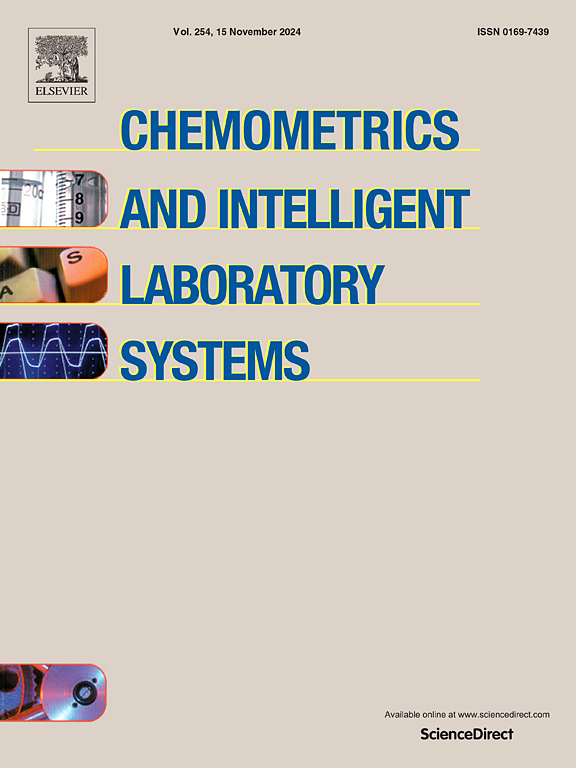UV–Vis spectralprint-based discrimination and quantification of sugar syrup adulteration in honey using the Successive Projections Algorithm (SPA) for variable selection
IF 3.7
2区 化学
Q2 AUTOMATION & CONTROL SYSTEMS
Chemometrics and Intelligent Laboratory Systems
Pub Date : 2024-12-26
DOI:10.1016/j.chemolab.2024.105314
引用次数: 0
Abstract
This work developed, for the first time, an improved analytical strategy for discriminating and quantifying honey adulteration by adding corn and agave syrups using the Successive Projections Algorithm (SPA) for variable selection in UV–Vis spectral analysis. Sample preparation involved dilution in water alone for obtaining the spectralprint data. By applying the first derivative Savitzky-Golay smoothing to spectra and interval selection by SPA, the iSPA-PLS-DA algorithm (Partial Least Squares - Discriminant Analysis) correctly classified all test samples (i.e., 100 % sensitivity, specificity, and accuracy) selecting 4 out of 15 intervals. Additionally, the quantification of adulteration honey using the iSPA-PLS algorithm achieved the lowest relative error of prediction (REP) and limit of detection (LOD) values of only 5.89 % and 7.02 mg g−1, respectively, selecting 10 out of 20 intervals. The proposed method aligns with White and Green Analytical Chemistry principles, being simple, quick, affordable, and eco-friendly. It also aids in developing future protocols and legislation for honey quality.
采用连续投影算法(SPA)进行变量选择的基于UV-Vis光谱打印的蜂蜜中糖浆掺假的鉴别和定量
本文首次提出了一种改进的分析策略,利用连续投影算法(SPA)在紫外可见光谱分析中选择变量,通过添加玉米和龙舌兰糖浆来区分和定量蜂蜜中的掺假成分。样品制备包括在水中单独稀释以获得光谱打印数据。iSPA-PLS-DA算法(偏最小二乘-判别分析)通过SPA对光谱和区间选择应用一阶导数Savitzky-Golay平滑,从15个区间中选择4个正确分类所有测试样本(即100%的灵敏度、特异性和准确性)。此外,使用iSPA-PLS算法对掺假蜂蜜进行定量,预测的相对误差(REP)和检出限(LOD)值分别仅为5.89%和7.02 mg g - 1,选择了20个区间中的10个。该方法符合白色和绿色分析化学原理,简单、快速、经济、环保。它还有助于制定蜂蜜质量的未来协议和立法。
本文章由计算机程序翻译,如有差异,请以英文原文为准。
求助全文
约1分钟内获得全文
求助全文
来源期刊
CiteScore
7.50
自引率
7.70%
发文量
169
审稿时长
3.4 months
期刊介绍:
Chemometrics and Intelligent Laboratory Systems publishes original research papers, short communications, reviews, tutorials and Original Software Publications reporting on development of novel statistical, mathematical, or computer techniques in Chemistry and related disciplines.
Chemometrics is the chemical discipline that uses mathematical and statistical methods to design or select optimal procedures and experiments, and to provide maximum chemical information by analysing chemical data.
The journal deals with the following topics:
1) Development of new statistical, mathematical and chemometrical methods for Chemistry and related fields (Environmental Chemistry, Biochemistry, Toxicology, System Biology, -Omics, etc.)
2) Novel applications of chemometrics to all branches of Chemistry and related fields (typical domains of interest are: process data analysis, experimental design, data mining, signal processing, supervised modelling, decision making, robust statistics, mixture analysis, multivariate calibration etc.) Routine applications of established chemometrical techniques will not be considered.
3) Development of new software that provides novel tools or truly advances the use of chemometrical methods.
4) Well characterized data sets to test performance for the new methods and software.
The journal complies with International Committee of Medical Journal Editors'' Uniform requirements for manuscripts.

 求助内容:
求助内容: 应助结果提醒方式:
应助结果提醒方式:


